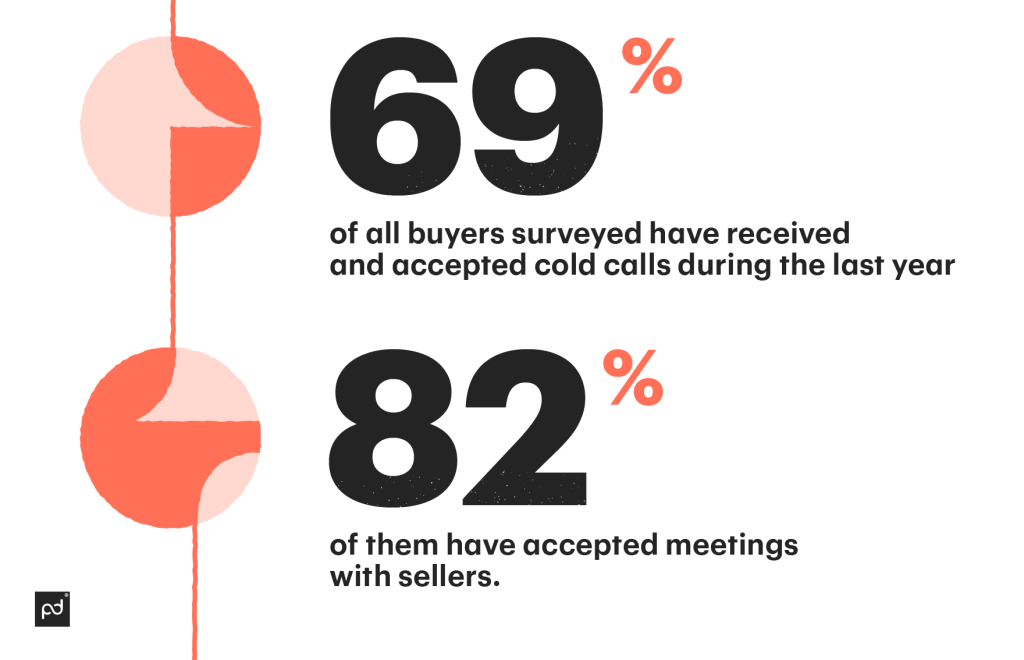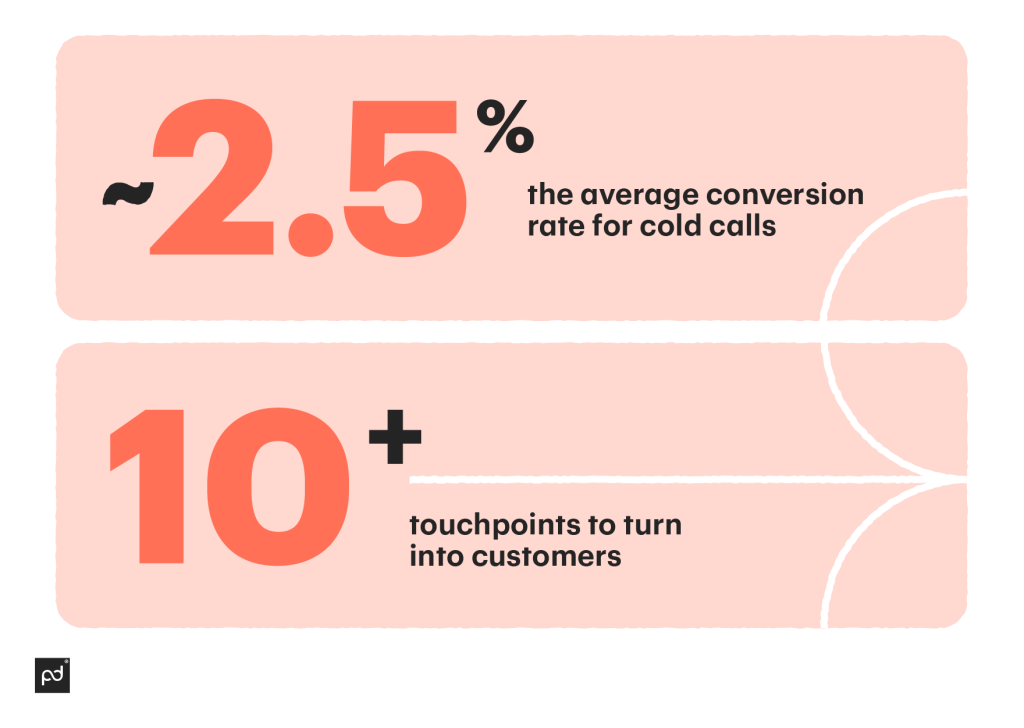It may seem that cold calling in sales is dead — but the numbers say otherwise.
According to research conducted by the RAIN Group, 69% of all buyers surveyed have received and accepted cold calls during the last year, and 82% of them have accepted meetings with sellers.

This means cold calls are still a powerful sales channel that shouldn’t be overlooked.
At the same time, the average conversion rate for cold calls is just about 2.5%, and today’s visitors need 10 or more touchpoints to turn into customers.

This means that today’s cold calls must be very well prepared to be efficient enough.
So, answering the question “What is the best cold calling script?”, we can say that this is the script that converts your cold contacts into prospects in the most efficient manner possible.
In the article below, we’ll review the most efficient cold-calling scripts with examples, and offer you several valuable tips on how to increase your success rate during cold-calling.
Let’s go!
Best cold-calling scripts with templates
Every cold calling script focuses on a particular prospect, the challenges presented, and the related KPIs to keep in check. And thankfully, there is a cold calling script for every situation.
Here are a few examples of cold-calling scripts that can help you and your sales team deliver effective sales pitches.
For your convenience, in all the scripts below, S means the salesperson, or sales rep, and C means the customer.
1. HubSpot universal sales script template
The best fit for different situations.
Generally, HubSpot’s script consists of four parts: introduction, leading question, positioning statement, and call-to-action.
This approach can be adjusted to any certain case in accordance with the intended purpose.
In a nutshell, the script looks as follows:
S: Hello! My name is <your name>, I’m working at <provide your company name>.
C: Hello (and the phone isn’t still off)…
S: I’ve been researching … and found an issue <describe the issue in a few words>. I’d like you to hear more about it. Within our work, we’ve met similar challenges a couple of times and solved them using <provide short descriptions of possible relevant solutions>. What do you think, would one of these solutions be sufficient in your case?
C: (option 1) Yes, I think one of those might help, please tell me more.
S: (option 1) <Congrats, your opponent has just turned into a prospect. Now you should continue nurturing them>
C: (option 2) <any objection>
S: (option 2) Thanks, I understand. Would it be ok if I send you a follow-up email tomorrow or call back later?
C: (option 2.1) Yes.
S: (option 2.1) <send the follow-up email as promised and then continue nurturing>
C: (option 2.2) No.
S: (option 2.2) Ok, I understand. Thanks for your time! And could you connect me with anybody from your company who’s responsible for addressing these challenges? <try to continue communicating>
2. Sales script with options
The best fit for increasing chances of building a rapport.
The next script offers the prospect a choice from several available options.
Such an approach significantly boosts the chance your prospect will choose any of the options offered instead of rejecting your offer altogether.
S: Hello! My name is …, I’m working at … .
C: Hello.
S: I’ve been researching … and found an issue <describe the issue in a few words>. Is that something you’re interested in?
C: Yes.
S: There are two ways we can proceed on this issue. The first one is <describe the first approach>, which is <show pros and cons>. And the second one is <describe the second approach>, which is <show pros and cons>. Which one looks more interesting and applicable to your case?
C: <chooses the option>
S: Great! Can I start by asking a couple of questions? <then ask qualifying questions, describe the selected option, offer to ask their questions, and schedule the next meeting>.
3. Script for reaching decision-makers
The best fit for reaching the companies with decision-makers that are unknown or difficult to reach.
To be honest, when making cold phone calls, most of the time you meet generic staff members, not decision-making executives.
These staff members are usually called gatekeepers.
So, If you’re unsure your cold contact is one of them, or you cannot engage with the required person directly, there is a special script designed to help you reach the decision-maker.
The idea is to make the person you’re calling feel important and then establish a rapport.
S: Hello! My name is … . I’m wondering if you could help me. Unfortunately, I was unable to find your name before calling. It would be super if I knew your name before continuing the conversation.
C: Hello. My name is … .
S: Thank you very much, <name>! I’d like to speak with <name if you know the person>/the person who’s in charge of the <define the challenge they have and you offer to overcome>. Is that you?
C: No, I’m just…
S: What a shame! If all the executives had the same communication skills as you, the world would be a much better place! Could you please help me connect with the right person?
4. Script for getting more info
The best fit for situations with insufficient data.
If your cold call is really brain-freezing and you have almost no clue about the prospect’s name and its business, the first goal is to get more helpful information.
Even in those cases where you already know something about the case, there is always room for additional knowledge.
But sometimes you don’t even know whether they have a need for your product/service. So, asking questions is a convenient way to learn more about the prospect first-hand.
S: Hello! My name is …, I’m working at … .
C: Hello.
S: <any message for building a rapport> Could I ask you a couple of questions?
C: Sure.
S: <ask the questions that will help you get into the situation. For example, about their decision-making process, their budget, etc. >
5. Script based on mutual connection
The best fit for those situations where you have a mutual connection with the prospect.
A common connection can raise your chances of engaging the prospect.
Even if the mutual connection is someone you’ve seen just a couple of times in your LinkedIn feed, this can help make the cold call much warmer.
S: Hello! My name is …, I’m working at … . I’m calling you on behalf of … .
C: Hello.
S: For <person>, we’ve just solved the <describe the issue you’ve allegedly solved for the person you’ve mentioned. The issue must be relevant to the prospect’s business, too>, and then we talked about who else might find this helpful. <Person> mentioned you; I then came across your business and made a point to call. I’d like to show you how we achieved <result achieved for the person’s company>. Would this be interesting for you?
*Note: in any uncertain moments, you could mention the mutual contact as a source of additional info you aren’t aware of (This data could be a corporate secret. Let me please discuss it with <person> before unveiling it to you).
6. Script for better personalization
The best fit for the cases where you can obtain many different types of information.
Some prospects are highly active on social media, which makes it possible to learn a lot about them, their behavior, desires, etc.
A similar situation could be presented regarding the business itself. You might even be lucky enough to find all the details required for optimizing negotiations.
So, it would be ridiculous not to capitalize on that situation.
S: Hello, … ! My name is …, I’m working at … . I see you’ve worked at <one of the previous occupations>. And I know, they <any fact helping to build a rapport> — what are your thoughts?
You can use any info you find to (professionally and respectfully) get your “hooks” into the prospect.
7. Script for busy people
The best fit for the instances where the customer is polite enough but ready to hang up the phone at any moment.
Some prospects end cold sales calls with phrases like “I’m too busy now.” Most often it means that your prospect doesn’t want to say “No” directly but has it in their mind just the same.
Even though this is happening, it is still possible to steer the conversation back on track.
All you need to do is convince the prospect that you have something that’s in their best interest and worth their time.
<…>
C: Sorry, I have no time for this.
S: I understand you. To be honest, I’ve heard this phrase many times. But almost everyone who’s decided to continue the conversation in similar cases was very satisfied after our brief discussions. Give me just a minute, after which you’ll be absolutely sure whether my offer is valuable for you or not.
8. Script based on special offers
The best fit for different situations.
A special offer script works wonders! It can create an engaging dialogue with your prospect that doesn’t make your (or your sales reps’) pitch sound salesy or spammy.
However, your special offer should be relevant to your prospect’s business.
Remember, your goal here is to engage in a conversation and know more about your prospect’s business.
S: Hello, … ! My name is …, I’m working at … . I’m reaching out to let you know about the special offer we currently have covering <a relevant, significant detail of the prospect’s business>, ending at <a date somewhere in the near future, which makes it available for the prospect to meet this deadline>. We’re offering <describe your offer in a nutshell>. Does that sound interesting to you?
C: (option 1) Yes.
S: (option 1) Wonderful! <Continue nurturing>
C: (option 2) No.
S: (option 2) Not a problem. Could we schedule a 10-minute call for the next week, if this time fits you better? <then, if they still don’t agree, just ask to send them an email>
9. Super short pitch script
The best fit for extremely busy prospects.
Putting your offer into a single sentence could be highly efficient in some cases. This approach excels when you have to relay your offering before the prospect hangs up the phone.
S: Hello, … ! My name is …, I’m working at … . And in a few words, we … <sound your one-sentence value proposition>. Is this something that would be interesting for you?
Some important cold-calling tips before you start
Before you start calling and/or building out your own cold-calling scripts based on our examples, we should go through some common tips.
1. Prepare a detailed outline first
Please don’t rely on hunches when creating your cold-calling scripts. Instead, you must first prepare an outline that’s as detailed as possible.
This will help you make your scripts more comprehensive and accurate, resulting in better conversion rates.
2. Keep your goals in mind
Remember the objective of your cold call: set up a rapport, validate your relevance, and start converting your prospect to the next funnel stages.
Always keeping your goals in mind during the cold calls helps you remain focused and on track.
3. Research thoroughly
The better you know the decision-maker and their business, the more chances you’ll have to find a fit. So, before dialing a phone number, conduct thorough research and gather all the details you can find.
The worst thing is when an unknown number calls you, and right after you’ve picked up the phone, the second party starts offering you something completely irrelevant without even asking you if you need it.
4. Use open-ended questions and employ active listening
In case the previous tip was insufficient, you should make what is called “a probing move” in chess. The idea is that people usually like talking about their jobs — you just need to help them start.
The open-ended questions (those which couldn’t be answered quickly) act exactly the same way, helping people loosen their tongues, and become relaxed.
Listen carefully and actively, ask clarifying questions, and you’ll likely get what you need.
5. Overcome the objections
With every new call, you arrange you’ll increase your collection of objections — and your arsenal for overcoming them!
Yes, some of the objections that you’ll be unable to overcome are due to the limits of your product or service. But most of them can (and will!) definitely be addressed.
6. How about pain points?
Don’t rely on only the value-add in your cold calls. Sometimes your prospect has pain points, fears, and issues that outshine the value you can offer.
And if you know for sure how to help them overcome these issues, you could easily find common ground with your future customer.
7. Leverage their job openings
Sometimes open positions can reveal a lot about the needs of a company. The simplest example is software outsourcing companies.
When any company hires JavaScript developers, it’s time for outsourcers to offer them a solution to handle their development needs.
8. Choose the most appropriate time for calls
Remember to keep track of when most prospects are likely to answer a call. Doing prior research will help you make a bigger impact on your buyers.
Build a schedule and stick to it. Don’t just call people at random times and any day of the week. Your prospects will quickly grow tired of you and might just block your persistent calls.
In most cases, the best time frames for cold calls are between 11 am to 12 pm and from 4 pm to 5 pm Monday through Friday.
But in your case, they could be significantly different. Here you can act wisely and start by researching the other side deeper.
For example, using special software with document tracking features makes it possible to understand the behavior of your contract partners much better and adjust the time you’re selecting more accurately.
9. Respect their time
When building a rapport, it’s critical to show your respect toward the person you’re calling — the call is usually something unexpected for them, and you must ensure that the time is chosen properly when making contact.
Confirm as much in your first or second message. And only after the prospect agrees that they are ready to listen to you now, proceed with the next step of your script.
10. Practice until you’ve learned your script blindfolded
There is no room for any hesitations in your speech when cold calling.
So, spend ample time practicing your script. You can’t gush out the script text like a robot; rather, your voice must be natural, stay at a moderate tempo, and your manner must be friendly.
After making several calls, you’ll have a better understanding of any change(s) needed in order to increase your conversion rate.
11. Less “me,” more “you”
Sometimes it’s easy to fall into a conversation where you’re saying “I,” “me,” and “we” too often. Always pay attention to, and keep focusing on, your prospect.
Just think about how to form each sentence in your questions using the word “you” whenever possible. In a short amount of time, this type of messaging will become automatic.
12. Get ready for slammed-down phones
Some people can simply drop the phone off instead of declining more politely. This is always frustrating, and you must be ready to accept such an outcome.
Just consider these events as collateral damage — you shouldn’t take it to heart.
13. Spark an interest
AIDA, the oldest marketing model of customers’ decision-making, calls “interest” one of its four essential components.
Intriguing the other side builds rapport immediately — the person you’ve captivated during the first few seconds of the conversation will surely remember you until the next time you both speak.
14. Use case studies and other examples as a proof
Testimonials, references, referrals, and, at the very least, mutually known brands are your allies for proving you’re reliable.
Use case studies that show similar stories even if you’re unable to show their real names: today’s businesses clearly understand what an NDA is.
All this evidence will definitely help you build a stronger relationship with the prospect.
15. Lower the bar if needed
Sometimes it’s hard for your prospect to commit to buying something expensive from the very beginning. But it’s often possible to offer them something much less expensive, kind of a pilot project.
If you’re confident enough in your product or service, start with this “demo version” and then your prospect/customer will be more inclined to buy the rest for sure.
16. Use follow-ups and voicemails
Once your call is finished, always send the prospect a follow-up email with a conclusion of the call you both had.
Send them follow-ups also in those cases where you cannot reach them within a week or more. In the last case, a follow-up call is acceptable, too.
A brilliant approach is sending voicemails alongside your written ones. Dropping your prospect a voice message looks friendly and helps keep an established rapport strong.
Specific follow-ups, quotes, and other custom-made documents are rather labor-intensive.
Rather than creating them from scratch each time you need them, there is value in using the ready-made templates that different software companies offer.
17. Review your cold calls continuously
Continuous self-learning and improvement are a must for each sales rep looking to remain effective.
That’s why you should always review your cold calls, analyze what’s going wrong and what’s working, and then improve your scripts.
18. Teach your reps
Make cold calls together with your reps to show them your techniques and working style. With some calls, have them lead and then analyze the results together.
This is one way you can drastically improve the sales skills of your reps in a short period of time.
19. Optimize and automate
Once you’ve proven any successful approaches, it’s time to automate routines.
You’re likely already using any CRM system, so your cold calling-related activities must run within the system.
Use sales automation software along with your CRM to cover more ground simultaneously.
Your goal here is to find the sales management software which has out-of-the-box integration with the CRM your sales team uses.
20. But don’t become a robot yourself
If you’re repeating the same (or pretty similar) script, again and again, it’s really easy to start delivering your text without any emotional component.
Please don’t forget about your goals — and the fact that your prospect is a real, very much alive person.
Wrapping up
As you can see, cold calling is both quite challenging and yet still an efficient sales approach.
In a nutshell, achieving success here is as follows:
- You should start with thorough research and planning
- Then select the most appropriate template and form your own script
- Iterate and improve your script, using different techniques and feedback
- Automate what’s successful and benefits from automation.
You can also read our eBook “Perfecting the pitch: Pro tactics for mastering every type of sales deal” created in a collaboration with the experts of HubSpot.
Here you can find more valuable tips and scripts about cold calling, as well as an even more comprehensive guide on how to build an effective sales process.
Originally published January 11, 2020, updated September 14, 2022
Disclaimer
PandDoc is not a law firm, or a substitute for an attorney or law firm. This page is not intended to and does not provide legal advice. Should you have legal questions on the validity of e-signatures or digital signatures and the enforceability thereof, please consult with an attorney or law firm. Use of PandaDocs services are governed by our Terms of Use and Privacy Policy.


